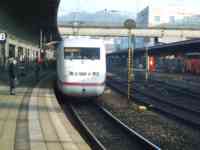
| Path: Eric's Site / Eric / Travel / Germany / Journal 6 | Related: Germany, Journal 0 1 2 3 4 5 6 7 8 9 10, Visits (Site Map) |
I could have sworn there were hard parts in the FFT. There were hard parts the first time I wrote an FFT. However, completing the separated-data FFT is the major part of this project. The remaining two functions build on it in straightforward ways. So, I will be done with this project very early.
Martin mentioned last week that Mercury Computer System's FFT runs in 9700 CPU cycles for 1024 elements. That is 300 cycles slower than the one I wrote for Sky Computers. That was two years ago, and Mercury has not caught up yet.
I wondered about the 1864 in my gym's name, TSG Söflingen 1864 e.V., and
today I saw a plaque on a stone that confirms that is a year. Apparently my
gym has been around for 139 years.
 |
| My train approaches. |
Surprisingly, my train was 15 minutes late. After boarding, I looked at
scenes like those below for a while and then read Analog until we
reached Munich.
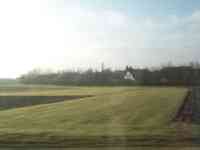 |
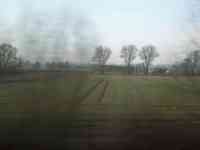 |
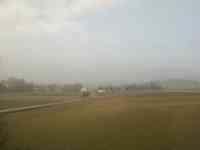 |
| A view from the train. | Another view from the train. | Yet another view from the train. |
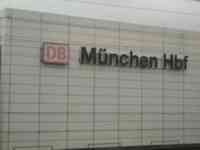 |
| We arrive in Munich. |
Munich is a big city and shares much with other big cities. In doing so, it
loses some of the charm of smaller cities. I like Ulm better. Getting around
was fairly easy, except for crossing streets in some places, until I realized
my error. In some places in Ulm and Munich, I have ignored stairways descending
underground. In Boston and New York, those are usually subway entrances, so
they are irrelevant unless you want the train. In Ulm, they are pedestrian
underpasses. In Munich, they are both. In a few places in Ulm, crossing the
street on the surface requires going around three sides of a square, which
can be a tedious process because each side may have multiple segments with
individual crossing signals. So the underpass is easier. I saw an intersection
or two in Munich where none of the corners were connected by crosswalks, so
I was confused about how to get across until I realized the subway entrance
was not only a subway entrance.
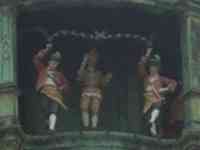 |
| Glockenspiel in Marienplatz. The figures are life-size. |
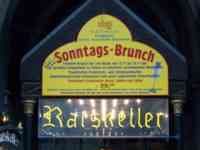 |
| Ratskeller München. |
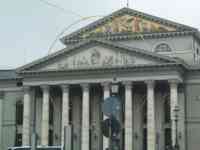 |
| Pierced building. |
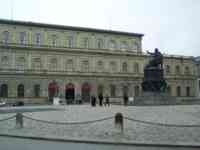 |
| One of many monuments. |
After Marienplatz, I went to Amerika Haus Verein. The web pages of the US
consulate in Munich suggested Amerika Haus Verein housed several Germany-US
business, cultural, and social organizations. But according to the guard,
it was just a library. I am not sure why a library needs to search and scan
people on the way in. From there, I walked to the consulate, but I got
there after the hours for consular services, 8 a.m. to 11 a.m. Either our
taxes are not paying for full workdays there or the consulate spends most of
its day doing non-consular things.
 |
| Whom are they expecting? |
 |
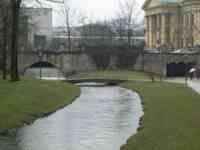 |
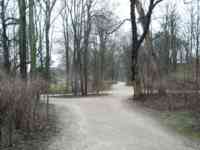 |
| Pond in the English Gardens. | Stream in the English Gardens. | Paths in the English Gardens. |
 |
| Very high volume river. |
Leaving the English Gardens, I saw a car with an Herbalife ad on the side.
That's a shame. (Herbalife is implicated in some illegal pyramid schemes
that have financially ruined a number of people.)
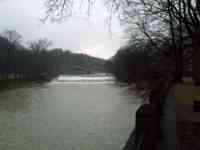 |
| Isar River. |
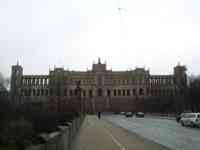 |
| Maximilianeum. |
 |
| Rock-climbing wall in a playground. |
After walking a bit more, the urban density decreased again. I was looking for one of the game stores I had looked up in the telephone directory. I found the street, and the street numbers told me I had a way to go. I had been walking for about four hours continuously, so I hopped a bus. It is easy to get around; there are buses and trains all over. I did not need to plan any routes, just check my map for whatever was in the area and going my way. After I found the game store and bought a couple of games and checked another store in the area (and saw a bicycle store with a clever name, "Velosophie—more than bikes"), I took a bus to the subway and the subway back downtown.
The subways have maps on the ceilings, so your view of a map is not obscured when the subway is crowded. The subway doors do not open by themselves. You have to turn and pull a handle. A machine does take over after you have moved the door a little. I wonder what the purpose of that is? It cannot save much power.
Munich has two sets of train lines, labeled S-Bahn and U-Bahn. I do not know what the difference is. They were both underground at the Hauptbahnhof, but maybe the S-Bahn goes to the surface somewhere?
I have mentioned the public-transit semi-honor system before. A sign on the subway indicated that if you are discovered without a valid ticket, you are charged a €40 fare, and there could also be an administrative fine and criminal prosecution. The punitive fare by itself would not be enough to deter lawbreakers, since the frequency of inspections is so low.
I reached the Deutsches Museum with only 90 minutes available in my schedule, so I did not go in. The museum could be good for a trip when somebody visits me, if we want to spend a full day there. It is 46,000 meters2, and there is a 144-page museum guide (for €4). Their map shows a section labeled Mountain Railways and another entire section labeled Model Railway.
I left the Deutsches Museum and headed back toward the city center. A few
blocks from the museum, I entered a quiet street. This was quite odd. There
was traffic nearby, but there were no cars driving on this street. In Boston
around 4 p.m. on a Friday, I would expect every through street to be
crawling with traffic. This Munich street was accessible and downtown and
appeared to connect points of interest, but nobody was driving along it.
It was lined with parked cars, and there was little noise from nearby
traffic. Actually, Munich is quiet in general compared to big US cities,
but this street was particularly quiet. It was not part of a pedestrian
zone. It was lined with retail stores and some residential buildings.
There were a dozen or so pedestrians walking along it. They were quiet too!
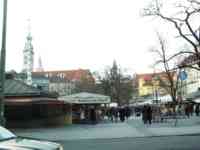 |
| Viktualienmarkt. It is much larger than can be seen in the photograph. |
Throughout the day, I took photographs of a few street scenes, to show you some of the architecture and flavor of the city. Those are below.
I headed back to Marienplatz and had dinner in the Ratskeller. They had only
a few vegetarian choices, and only one of them was German, the
krauterkäsespätzle. That is herb pasta with cheese and fried
onions. (Two other vegetarian dishes were a Macao platter and Swiss potatoes.)
I had tried käsespätzle (plain pasta, not herb pasta) at
another restaurant and did not find it interesting, so I was inclined to skip
it, but I decided to favor the German dish and give it a second chance.
Unfortunately, it still was not interesting. The Spätzle with
sauerkraut at the Christmas Market was fine, but käsespätzle
does nothing for me. There are some restaurants here in Ulm which are
supposed to have other, good vegetarian Swabian dishes, so I will
get around to them eventually.
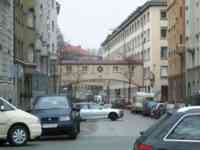 |
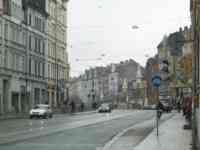 |
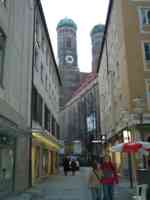 |
| Munich street scenes. | ||
Continuing through Marienplatz, there was an anti-war rally going on. One difference between rallies in the US and rallies here is that passersby here actually pay attention to the event. People were talking to the participants and looking at the literature and so on. This of course shows that Europeans are not as well informed as US citizens, as Europeans still believe that citizens matter in democracy or that a candidate who gets the most votes will win an election.
I did not find many chocolate stores in Munich. There was one in Marienplatz,
so I did not come away empty-handed, but I will have to check the telephone
directory for more before I go back. I did see several Segafredo restaurants,
and they have them in Ulm too, and now I have seen Segafredo so often I cannot
remember if we have it in the US or not. There are also philately stores in
Ulm and Munich. They exist in the US too, but it is not such a popular hobby
there that the stores can afford a high-rent area like the main shopping
district.
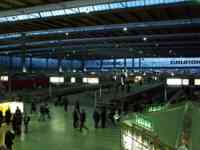 |
| Leaving Munich. |
Another difference between the US and Germany is that construction sites
here are not obsessively walled off from the public. A site that is some
distance from pedestrians may be open. A site that is in a pedestrian area
may be separated by only light disconnected fencing (that is, with gaps
you could squeeze through or even walk through in some places). They must
expect pedestrians here not to be idiots or to be rewarded by the courts
for being idiots.
I think I have finished my US income tax return. It is hard to be sure, but I worked through all the steps carefully, and each thing seemed clear by itself. Still, my return has lots of interesting features this year. First, I worked very little during the year, so my taxes are zero. Second, I did work some, so I qualify for the Earned Income Credit. Third, I paid foreign income taxes, so I can take a tax credit for those or an income deduction. Fourth, I incurred job-related expenses, so I get to deduct those.
There are additional details that I will spare you. Next year, I should be able to deduct my entire lease here and $29.50 per day for meals and travel home. (The meal deduction is figured at a fixed rate depending on the country you are in, not at the actual expense.) I will also get a credit for all the German income taxes I pay.
The Usenet newsgroup rec.humor.funny
carried a great dialog regarding Iraq disarmament.
Here is the
article.
Anyway, Wednesday after class, I get on a train to Paris. Thursday I meet Simone, and we spend Thursday, Friday, Saturday, and Sunday in Paris. Sunday night, we get on a train to Ulm, and Simone visits Ulm. Wednesday she leaves Ulm.
If it were not for the complicated arrangements, international travel would be a lot simpler from here than from the US. Just hop on a train, cross a few borders, and see Europe. The travel plans have been made quickly, and I do not even have the address of the hotel yet.
Two more new students showed up in class tonight, one from Brazil and another from Estland (Estonia). It is not in my German-English dictionaries. It is interesting that the students come from so many different countries. Except for the cluster of Iranians, there are only one or two students from each other country. I would have expected immigration to occur in waves, so you would get clusters of people from various countries at various times, rather than an even distribution.
Deutsche Post has machines that dispense stamps. After you pick the number of stamps of each denomination you want, it prints them. They have the common denominations for various things, like a standard letter, an international postcard, and so on. But they did not have a denomination for an international letter, €1.50, and I did not have time on the way to work this morning to pick out a combination that added up to it. Since the machine prints stamps on the fly, why can't it print any denomination?
I wonder if the German word jetzt, meaning "now," is related to the
English work "just," as in "this just in." It is a stretch by itself, but
it seems reasonable given all the cognates between English and German I have
seen. Take the numbers for example—eins-one, zwei-two,
drei-three, and so on. Clearly they have become very different. Yet
they are clearly related—sechs-six, sieben-seven,
elf-eleven, zwölf-twelve. Both number systems have
special words for eleven and twelve but go into -zehn or -teen patterns
at thirteen. That is not just chance. It is odd that you would keep so much
that seems largely irrelevant (like having special words for eleven and twelve)
but change so much that seems meaningful (pronunciations and spellings).
I got email (from the .cy domain!) from the second of the two management companies involved in my German employment, with a statement about payments for the first three milestones. In 2002, the amount I held in a foreign bank account was low, but, next year, I will have to add a form to my tax return about having money in a foreign account.
I leave Ulm right after class and get back the day of the next class, so
I will have to do my German homework in France. Two foreign languages
competing in my brain at once! I am in the habit now of saying common
phrases in German, so I will probably say Danke and Wiedersehen
to some French people.
I went to class tonight and learned some new things.
The period after numbers in like 17. März or building floors like
1.Obergeschoß is the equivalent of the English ordinal
superscript. 17. März is not just March 17; it is
March 17th, and 1.Obergeschoß is 1st floor.
The telephone company's computer called again and asked me to press one to
do something about the voice mailbox, so I tried it, hoping it would leave
me alone. Now the voice mailbox is on, which is very bad. It will take
messages, and I do not know how to retrieve them or even to check if there
are any. If you call me and get the voice mailbox, do not leave a
message. If I cannot figure out how to get messages, I will have to
get the phone company to turn the service off again.
Simone is on the Nacht Zug to Paris, so I am alone again. It was a terrific visit. We have been walking most waking hours for the past seven days, almost enough to offset the food. I learned some things about the things to do and see in Ulm, so I may update that part of my index page and will prepare for future visitors.
Tomorrow I return to work. In the evening, I will start sorting through my notes and the 436 photographs to prepare journal entries for the past week. If you have not already seen the separate web pages for the Paris visit and Simone's Ulm visit, you should look at them now.
My brother, Alex, confirms the Munich S-Bahn is mostly a street train and
is designed for street loading and the U-Bahn is mostly an underground train
and is designed for platform loading. [Late update: The former is
inaccurate. The S-Bahn is the SchnellBahn that provides fast
transportation in the city and an area around it.]
While I was preparing for the Paris trip, I had to write a bank transfer to send money for the hotel room. Now that I have had some experience with the transfers, I do not see the advantage over checks. Anybody could fill out a transfer form and drop it in the bank's collection box, and the bank would not verify the signature any better than it does with checks. Perhaps there is an advantage in that the transfer goes to another account, whereas anybody can walk in off the street to cash a check. If the destination bank has a responsibility for identifying their account holder, the funds of a forged transfer might be recovered more easily than for a check. However, the transfer was a nuisance to use because it was days before any confirmation was available to me that the payment had been received. If an error had been made telling me the destination account number, I might not have had a hotel room available in Paris. A mailed check takes a while too, but I might have been able to hand a check to the travel agent and know right away the payment would go through.
Argh, the phone company computer called again. I think it might be trying
to get me to listen to messages that have been left for me. The printed
instructions that were sent cover turning some features on and off but not
listening to messages. I will have to check and see if there was a PIN or
something in them.
I went to the telephone company store downtown and got instructions for using or disabling the answering service.
| Ikea store in Ulm. |
I got home and found mail to me in Germany from Australia. My ex-girlfriend Jessica is there on an academic exchange program. With her letter, she sent a bunch of sparkly stickers with pictures of chocolates.
I can make out enough of the telephone service instructions that I might be able to set the answering mode or even retrieve messages, but it requires a PIN. Apparently I could have set the PIN during one of those calls from the phone company computer, but of course I did not. I do not know what it is set to now, if anything. So I just called the phone company and asked them to turn it off. That is supposed to take effect tomorrow. Monday, I will call my phone from elsewhere and hope:
At work, I got the assembly code for the interleaved-data FFT working. I still have to document it, optimize it, and fit it together with the split-data FFT nicely. That will complete milestone six. Milestone seven is the real FFT, which may take a couple of weeks. There is officially a milestone eight, but it is paperwork. It looks like I will finish in April.
Some more notes from class: Most students have only two names, no middle
name. Apparently the custom in Tunisia when a student has a question is
to walk up to the teacher to ask, even when the teacher is in the middle
of instructing the class. Leila has done that several times.
I also looked for a jacket. It is sometimes too warm to wear my winter coat. My spring jacket was in the package that is lost, so I need to replace it if the package does not turn up very soon. I found a nice jacket and encountered another cultural difference. The jacket has a zipper, and the tab is on the left. That is the opposite of men's jackets in the US. I do not know about women's jackets. It was marked as a man's jacket. I suppose I could get used to it.
Speaking of the temperature, there is often a sharp temporal temperature gradient during the day here. Going out in early morning, it can be very cold, but it usually warms up during the day. If it is a sharp chill at sunrise, it can be tolerable at 10 a.m. and warm in the afternoon. It was a mild chill this morning, and I walked to and from the gym and the mall in shirtsleeves this afternoon.
I finished the initial draft of my web pages describing the Paris trip. There
is still more to review and add. Probably this weekend I will post the pages
on the web.
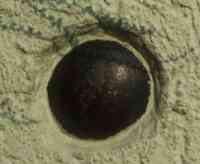 |
| Cannonball. |
While walking to and from Zur Forelle, I noticed three more sparrow
sculptures. Andreas says 256 were made.
 |
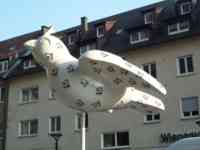 |
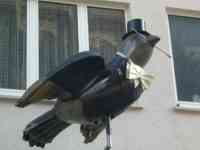 |
| Barber sparrow. | Sparrow decorated with sparrow-symbols. The lettering says Ulmer City/Alles drin!, "All inside!" | Tuxedo sparrow. |
| Path: Eric's Site / Eric / Travel / Germany / Journal 6 | Related: Germany, Journal 0 1 2 3 4 5 6 7 8 9 10, Visits (Site Map) |
© Copyright 2003 by Eric Postpischil.